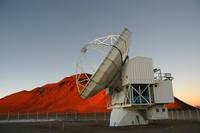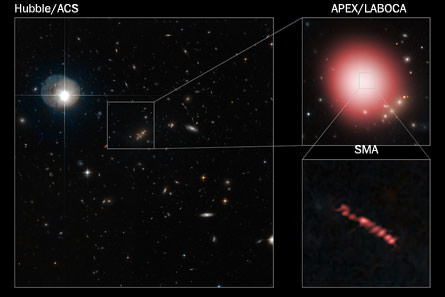[/caption]
Einstein started it all, back in 1915.
Eddington picked up the ball and ran with it, in 1919.
And in the last decade or so astronomers have used a MACHO to OLGE CASTLES … yes, I’m talking about gravitational lensing.
Now LABOCA and SABOCA are getting into the act, using Einstein’s theory of general relativity to cast a beady eye upon star birth most fecund, in a galaxy far, far away (and long, long ago).

How galaxies evolved is one of the most perplexing, challenging, and fascinating topics in astrophysics today. And among the central questions – as yet unanswered – are how quickly stars formed in galaxies far, far away (and so long, long ago), and how such star formation differed from that which we can study, up close and personal, in our own galaxy (and our neighbors). There are lots of clues to suggest that star formation happened very much faster long ago, but because far-away galaxies are both dim and small, and because Nature drapes veils of opaque dust over star birth, there’s not much hard data to put the numerous hypotheses to the test.
Until last year that is.
“One of the brightest sub-mm galaxies discovered so far,” say a multi-national, multi-institution team of astronomers, was “first identified with the LABOCA instrument on APEX in May 2009” (you’d think they’d give it a name like, I don’t know, “LABOCA’s Stunner” or “APEX 1”, but no, dubbed “the Cosmic Eyelash”; formally it’s called SMMJ2135-0102). “This galaxy lies at [a redshift of] 2.32 and its brightness of 106 mJy at 870 μm is due to the gravitational magnification caused by a massive intervening galaxy cluster,” and “high resolution follow-up with the sub-mm array resolves the star-forming regions on scales of just 100 parsecs. These results allow study of galaxy formation and evolution at a level of detail never before possible and provide a glimpse of the exciting possibilities for future studies of galaxies at these early times, particularly with ALMA.” Nature’s telescope giving astronomers ALMA-like abilities, for free.
OK, so what did Mark Swinbank and his colleagues find? “The star-forming regions within SMMJ2135-0102 are ~100 parsecs across, which is 100 times larger than dense giant molecular cloud (GMC) cores, but their luminosities are approximately 100 times higher than expected for typical star-forming regions. Indeed, the luminosity densities of the star-forming regions within SMMJ2135-0102 are comparable to dense GMC cores, but with luminosities ten million times larger. Thus, it is likely that each of the star-forming regions in SMMJ2135-0102 comprises ~ten million dense GMC cores.” That’s pretty mind-blowing; imagine the Orion Nebula (M42, approximately 400 parsecs distant) as one of these star-forming regions!
James Dunlop of the University of Edinburgh suggests that such galaxies as SMMJ2135-0102 formed stars so abundantly because the galaxies still had plenty of gas – the raw material for making stars – and the gravity of the galaxies had had enough time to pull the gas together into cold, compact regions. Before about 10 billion years ago, gravity hadn’t yet drawn enough clumps of gas together, while at later times most galaxies had already run out of gas, he suggests.
But I’m saving the best for last: “the energetics of the star-forming regions within SMMJ2135-0102 are unlike anything found in the present day Universe,” Swinbank et al. write (now there’s an understatement if ever I’ve heard one!), “yet the relations between size and luminosity are similar to local, dense GMC cores, suggesting that the underlying physics of the star-forming processes is similar. Overall, these results suggest that the recipes developed to understand star-forming processes in the Milky Way and local galaxies can be used to model the star formation processes in these high-redshift galaxies.” It’s always good to get confirmation that our understanding of the physics at work so long ago is consistent and sound.
Einstein would have been delighted, and Eddington too.
Sources: “Intense star formation within resolved compact regions in a galaxy at z = 2.3” (Nature), “The Properties of Star-forming Regions within a Galaxy at Redshift 2” (ESO Messenger No. 139), Science News, SciTech, ESO. My thanks to debreuck (ESO’s Carlos De Breuck?) for setting the record straight re the name.


In fact, we did give this galaxy a nickname: “The Cosmic Eyelash”, because it’s just next to another objects called “The Cosmic Eye”.
” “Overall, these results suggest that the recipes developed to understand star-forming processes in the Milky Way and local galaxies can be used to model the star formation processes in these high-redshift galaxies.” It’s always good to get confirmation that our understanding of the physics at work so long ago is consistent and sound.”
This is indeed good news to see that our current models of star formation and SFR in distant galaxies are in agreement with observed properties. Concerning those models, a recent paper posted at arXiv.org has also looked at gas, dust, dark matter and SFRs of galaxies at z=2.3 and compared them to 2 galaxies observed in the HUDF that lie at comparable distances. Their extensive modeling of these distant galaxies also confirm that such models compare well with actual observations, especially for structures with sizes on the order of 100pc.
“High-redshift clumpy discs and bulges in cosmological simulations” by Ceverino et al. can be found here: http://arxiv.org/PS_cache/arxiv/pdf/0907/0907.3271v3.pdf . From the abstract: “We analyze the first cosmological simulations that recover the fragmentation of high-redshift galactic discs driven by cold streams. The fragmentation is recovered owing to an AMR resolution better than 70 pc with cooling below 10^4 K. We study three typical star-forming galaxies in haloes of approx. 5 10^11 Msun at z=2.3, when they were not undergoing a major merger.” Detailed simulations derived from their models are presented and values derived are similar to that found for “The Cosmic Eyelash”. It’s great to see this close correspondence between theory and observation.
Ooops, I should have stated in my previous post that SFRs in the simulations were well below that noted in the currently observed SFR in the “Cosmic Eyelash”, possibly due to its’ starburst activity as seen in ULIRGs, of which it is a member.
Here I go again. I know I promised not to be a pest but, wouldn’t a pure gas burn hotter and quicker than a mixture of gas and heavy metal particles esp. in the more pressured and confined “space” of ~12by ago (if the rs/d calculator for z=2.32 is correct)? I am also assuming nothing has escaped the confines of our known universe and that the laws of conservation hold.
I know I should probably look elsewhere to ask these kinds of questions but, UT, which I enjoy reading very much, always comes up with articles that tickle my tired old neurons and I have to ask. lol.
The heavier elements act in a way as catalysts for nuclear fusion. This is how the carbon cycle works. Heavier elements also help contain radiation inside the star. A pure hydrogen star is a strange beast, and these did appear as PopIII stars which began to form 400My after they big bang. These pure hydrogen stars are not opaque to radiation and so the thermalizing photons do not help maintain a hydro-thermo-dynamic equilibrium in the interior. They may have been in fact rather transient and very large, forming rapidly and booming out in huge supernovae. They in turn formed heavy elements which seeded the PopII stars, which while poor in heavy element (low metalicity) they have enough to act as normal stars.
LC
Thank you L.C. for your response. I believe I have some understanding of what you point out. Again, I thought the article was about, “why” the ultra high luminosities then as opposed to now but, re-reading, I guess it’s to point out the physics of star formation then are the same as now.
I was just considering the environment then (closer, denser, hotter, higher pressure, more gas, less solids) as opposed to now. Sorry if I haven’t made sense.
Since when does Nature own and operate telescopes? According to http://www.apex-telescope.org it is owned by a consortium of the Max-Planck-Institute for Radio Astronomy, the European Southern Observatory and Onsala Space Observatory of Sweden.
@ dudelman: The telescope is due to the optical effect of gravitation. There is a focusing of light with respect to the radius of the gravitational center, such as a galaxy, and a spreading of light perpendicular to the radius. This is a motivating element of the holographic principle of strings and black holes.
@ wjwbudro:The astrophysics of stellar formation is indeed essentially the same then as now. I am not highly knowledgable of stellar astrophysics, so I defer to others who are on that matter.
LC
Thanks again LC. I sure appreciate your taking time for us layfolks. I left out one other thing I was considering and that is (sorry for using the word) but, the transformations from the plasma soup to the gas to the agglomerations that triggered the start of star formation and the structure that followed. Same physics but applied differently? Hope I’m around for awhile longer. Hurry up Cern!
wjwbudro,
Star formation certainly involves a lot of different physical processes, especially when you’re looking at giant molecular clouds with masses in the million-sol range. In the ‘local’ universe we can study star formation over a range of metallicities, galactic environments, etc, but few of these come close to those at redshifts of 2 (and above).
Even locally there have been interesting developments quite recently, as the discovery of Green Peas by Galaxy Zooites shows.
What happened between the time the universe became transparent to photons (we see this as the CMB today, at z ~1100) and the oldest galaxies we see today (at z ~7) is something that can only be modeled (so far).